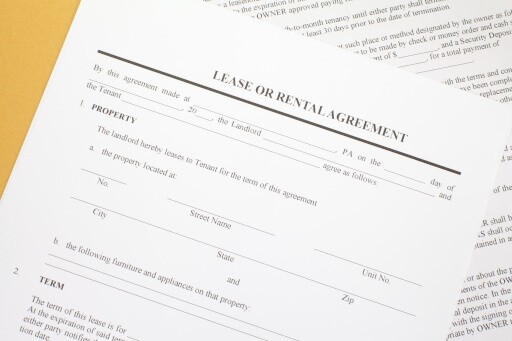Not every applicant will require a cosigner or a guarantor, but you may find a potential tenant who doesn’t quite meet your requirements to rent. If you’re willing to be flexible with your rental policies and still rent to the applicant, there are a few routes you can take. You can charge a higher security deposit, require first and last month’s rent upfront, or you can require a cosigner or guarantor. Any of these options help reduce the risk of signing a lease with a tenant who is missing a few qualifications but still has the promise of being a great tenant. But what exactly is the difference between a cosigner and a guarantor?
Cosigner vs. Guarantor: What’s the Difference?
Cosigner and guarantor are terms that are often used interchangeably, but when it comes to rental properties, there are key differences.
What is a guarantor?
A guarantor is an individual who chooses to take on the financial responsibility of the rental property should the tenant default on rent. A guarantor is not considered a tenant and is therefore not allowed to live in the unit. They are essentially a back-up plan for landlords and property managers in the case a tenant fails to pay rent or pay for damages done to the unit. A guarantor can be a parent, a family member, a close friend, or anyone willing and able to take on the responsibility.
What is a cosigner?
A cosigner differs from a guarantor in that they are essentially another tenant. The cosigner signs the lease with the tenant and has the right to occupy the unit. A cosigner can be a family member, significant other, or friend that is willing to share in the financial responsibility of rent, fees, and potential damages. This person may live in the unit and pay their own share of rent while also taking responsibility for paying the remaining portion of rent should the other tenant default on payment.
The most important difference between a cosigner and a guarantor is that a cosigner is immediately responsible for paying rent, just as the tenant is. A guarantor is only responsible for paying rent when the tenant fails to do so themselves.
When Should a Landlord Require a Cosigner or Guarantor?
There are several reasons a landlord may feel an applicant needs a cosigner or guarantor to sign the lease. Landlords typically have a set of requirements to rent that protect them from approving applicants who may not pay rent on time or take care of the property. If a tenant does not meet one or more of these requirements, you may find that a cosigner or guarantor can help reduce the risk. A tenant might need a cosigner if they:
- Have bad credit or no credit
- Don’t meet income requirements (typically three-times the rent)
- Lack good rental history
- Lack a steady employment history
- Can’t obtain landlord or employment references
Although there are other options, like charging a higher security deposit or requesting first and last month’s rent upfront, requiring a cosigner or guarantor is the best way to ensure that rent is paid. If your tenant doesn’t pay the required rent or fees, then the cosigner or guarantor is legally bound to do so in their place. Keep in mind that you can still base the cost of the security deposit and move-in fees based on the results of tenant screening. Apartments.com makes it easy to screen tenants, get the information you need, and find a qualified renter fast. Unlike our competitors, who use various third-party resources to collect information, we partner with TransUnion to provide you with screening reports for evictions, credit, and criminal history. Another feature you’ll find only on Apartments.com is support for co-signers, guarantors, and co-applicants. If you need more information to make a decision, you can request supporting documents from potential tenants directly on our platform. Get all the information you need to find the right tenant quickly and easily.
Should Landlords Screen a Cosigner or Guarantor?
Just as you screen every applicant who applies to rent your property, you should screen every cosigner and guarantor. This may include requiring proof of income and employment (usually in the form of pay stubs or bank statements), a background check, and a full credit check. This position comes with significant legal responsibility, so before you approve an applicant, you need to be sure their cosigner or guarantor is responsible enough to hold this title. After all, the purpose of requiring a cosigner or guarantor is to ensure that as the landlord, you receive rent payments and maintain a steady rental income from your investment.
What Role Does a Cosigner or Guarantor Play?
A cosigner and a guarantor are equally responsible for paying rent should the tenant fail to do so. The time frame in which a guarantor or cosigner is obligated to pay late rent is up to you and your local laws. If the tenant doesn’t pay rent on time and you charge late fees, then a late fee will be tacked onto that rent payment. If the tenant still doesn’t pay rent, then it will default to the cosigner or guarantor to pay rent (as well as the late fee, if applicable). Be sure to include the specifics of the cosigner or guarantor’s role in the lease agreement. Include when they are responsible for paying rent or fees, how they will pay it, and how they will be contacted about any missed payments.
As a Landlord, Should I Prioritize Applicants Who Don’t Require a Cosigner or Guarantor?
Landlords have the right to choose the most qualified applicant. You have the right to decline the application of a potential tenant who requires a cosigner or guarantor, even if they are otherwise a qualified tenant. If there is another qualified tenant who meets all your requirements to rent, it is within your legal right to accept their application over another, even if they weren’t the first applicant in line. As long as your decision is based on legitimate reasoning and is compliant with fair housing laws, you have the right to choose the best tenant for you and your rental property.











